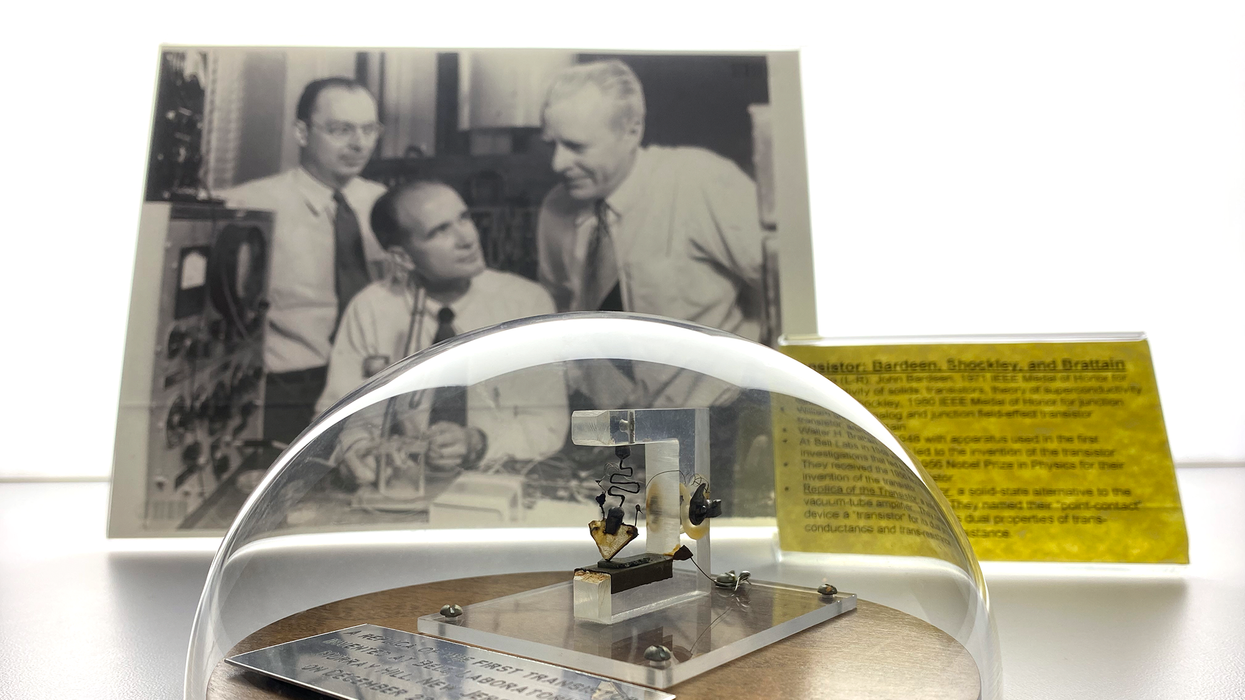The Device That Changed Everything

I was roaming around the IEEE Spectrum office a couple of months ago, looking at the display cases the IEEE History Center has installed in the corridor that runs along the conference rooms at 3 Park. They feature photos of illustrious engineers, plaques for IEEE milestones, and a handful of vintage electronics and memorabilia including an original Sony Walkman, an Edison Mazda lightbulb, and an RCA Radiotron vacuum tube. And, to my utter surprise and delight, a replica of the first point-contact transistor invented by John Bardeen, Walter Brittain, and William Shockley 75 years ago this month.
I dashed over to our photography director, Randi Klett, and startled her with my excitement, which, when she saw my discovery, she understood: We needed a picture of that replica, which she expertly shot and now accompanies this column.
This article is part of our special report on the 75th anniversary of the invention of the transistor.
What amazed me most besides the fact that the very thing this issue is devoted to was here with us? I'd passed by it countless times and never noticed it, even though it is tens of billions times the size of an ordinary transistor today. In fact, each of us is surrounded by billions, if not trillions of transistors, none of which are visible to the naked eye. It is a testament to imagination and ingenuity of three generations of electronics engineers who took the (by today's standards) mammoth point-contact transistor and shrunk it down to the point where transistors are so ubiquitous that civilization as we know it would not exist without them.
Of course, this wouldn't be a Spectrum special issue if we didn't tell you how the original point-contact transistor worked, something that even the inventors seemed a little fuzzy on. According to our editorial director for content development, Glenn Zorpette, the best explanation of the point-contact transistor is in Bardeen's 1956 Nobel Prize lecture, but even that left out important details, which Zorpette explores in classic Spectrum style in How the First Transistor Worked" on page 24.
The best explanation of the point-contact transistor is in Bardeen's 1956 Nobel Prize lecture, but even that left out important details.
And while we're celebrating this historic accomplishment, Senior Editor Samuel K. Moore, who covers semiconductors for Spectrum and curated this special issue, looks at what the transistor might be like when it turns 100. For The Transistor of 2047," Moore talked to the leading lights of semiconductor engineering, many of them IEEE Fellows, to get a glimpse of a future where transistors are stacked on top of each other and are made of increasingly exotic 2D materials, even as the OG of transistor materials, germanium, is poised for a comeback in the near term.
When I was talking to Moore a few weeks ago about this issue, he mentioned that he's attending his favorite conference just as this issue comes out, the 68th edition of IEEE's Electron Devices Meeting in San Francisco. The mind-bending advances that emerge from that conference always get him excited about the engineering feats occurring in today's labs and on tomorrow's production lines. This year he's most excited about new devices that combine computing capability with memory to speed machine learning. Who knows, maybe the transistor of 2047 will make its debut there, too.
This article appears in the December 2022 print issue.

The past, present, and future of the modern world's most important invention
How the First Transistor Worked
Even its inventors didn't fully understand the point-contact transistor
The Ultimate Transistor Timeline
The transistor's amazing evolution from point contacts to quantum tunnels
The State of the Transistor in 3 Charts
In 75 years, it's become tiny, mighty, ubiquitous, and just plain weird
3D-Stacked CMOS Takes Moore's Law to New Heights
When transistors can't get any smaller, the only direction is up
The Transistor of 2047: Expert Predictions
What will the device be like on its 100th anniversary?
The Future of the Transistor Is Our Future
Nothing but better devices can tackle humanity's growing challenges
John Bardeen's Terrific Transistorized Music Box
This simple gadget showed off the magic of the first transistor